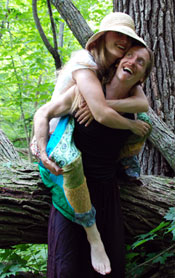All animals on the planet, including humans, tend to have their perceptions limited by such things as our size, the perceptual range of our senses, and the ecosystems in which we can survive. We humans, however, have managed to overcome some of those limitations. With submarines we can venture into the ocean depths where the pressures would otherwise kill us. With microscopes and telescopes we can extend the range of our senses, and transcend the barriers of our size, observing planets and microbes. Even if we don’t have high-powered microscopes, we can expand our usual view of nature if we take the time to get down and smell the earth after the first snows melt, or sit for hours in one place until the animals begin to forget we’re there, or turn upside-down to see what the world might look like to a squirrel who is climbing out of a tree. If we give ourselves enough time (a half-hour is good) for our eyes to adjust, we can see quite well even during very dark nights. And one of the easiest ways to see more of nature is to get up-close and personal using a magnifying glass or macro camera.
Yesterday, we did just that with some of the icicles that were hanging from our roof. We’ve seen icicles all our lives, and were used to seeing them from a single perspective — from a few feet away as we stood and observed. This time we got up close — really close — and looked at the end of an icicle as it dripped from the sun’s warmth. We had expected to find a sort of rounded tip of ice from which the water was dropping, but it wasn’t so. What we saw was a complex crystalline structure, grooved and angular and seemingly hollow-tipped. Its delicate beauty was nothing less than breathtaking.
This has us wondering — what other ‘everyday’ things around us would reveal amazing surprises if we took the time to look up close? Sounds like the beginning of a new quest . . .
Posted on February 22nd, 2010 by Kenton and Rebecca
Filed under: Natural Phenomena, Nature Inspiration




Oh I’ve got to go try this tomorrow.
It’s so cool! Each one is different, of course, with strange crystal formations magnified by the waterdroplets. If you get any great photos, send a copy our way!
We adore you two =)
Wow! Amazing photo and what a clear reminder of how beauty and mystery is always right there, waiting for us to recognize it!
Now I want to go out and take pictures of small things!
Hi Magnus,
Yipee! Isn’t it fun? It’s so amazing to realize that we live in this world where we can appreciate sweeping vistas and the leg-joints of a caterpillar. As you say, beauty and mystery everywhere!
Beautiful picture. I have always been fascinated by icicles. The sheer size of some of them defy logic. We have one hanging from the eave at my office that is easily 15 feet long. It is breathtaking. I just can’t seem to get the angle right for a picture that will do it justice. Why I never thought to look at them up close and personal I just don’t know. I will have to remedy that.
On our daily walks my 3 1/2 year old always insist on stopping to lick a huge shunk of ice that formed from water dripping. Never really thought about it like you write in your article.
Heidi Ahrens http://outdoorbaby.net
Hi MObugs,
We know exactly what you mean about ‘getting the right angle’. We love taking photos of ice and icicles, but to capture the ‘sensation’ can be really difficult, especially with those big ones. We want to get close to see the ridges and bubbles, and far away to see the size and overall flow. Photos aside, it’s such a joy to have these wonders hanging in the winter — swords for small children, mysterious formations for adults. What forces — wind, particle, reflected sunlight — conspire to give the icicle this curve or that strange projection? Amazing.
You two amaze me with your continued ability to find new perspectives on things most of us never think to look at differently.
A most incredible photograph!
Thanks Ted! We were astounded when we saw the crystals arrayed in that waterdrop. Much more mysterious than we would have supposed!